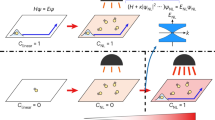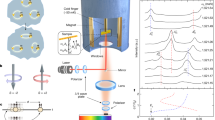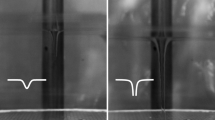Abstract
The concept of quasiparticles—long-lived low-energy particle-like excitations—has become a cornerstone of condensed quantum matter, where it explains a variety of emergent many-body phenomena such as superfluidity and superconductivity. Here we use quasiparticles to explain the collective behaviour of a classical system of hydrodynamically interacting particles in two dimensions. In the disordered phase of this matter, measurements reveal a subpopulation of long-lived particle pairs. Modelling and simulation of the ordered crystalline phase identify the pairs as quasiparticles, emerging at the Dirac cones of the spectrum. The quasiparticles stimulate supersonic pairing avalanches, bringing about the melting of the crystal. In hexagonal crystals, where the intrinsic three-fold symmetry of the hydrodynamic interaction matches that of the crystal, the spectrum forms a flat band dense with ultra-slow, low-frequency phonons whose collective interactions induce a much sharper melting transition. Altogether, these findings demonstrate the usefulness of concepts from quantum matter theory in understanding many-body physics in classical dissipative settings.
This is a preview of subscription content, access via your institution
Access options
Access Nature and 54 other Nature Portfolio journals
Get Nature+, our best-value online-access subscription
$29.99 / 30 days
cancel any time
Subscribe to this journal
Receive 12 print issues and online access
$209.00 per year
only $17.42 per issue
Buy this article
- Purchase on Springer Link
- Instant access to full article PDF
Prices may be subject to local taxes which are calculated during checkout






Similar content being viewed by others
Data availability
Data supporting the figures within this paper are deposited at https://doi.org/10.5281/zenodo.7295031.
Code availability
The code used for the analysis of the experiment, analytic modelling and simulations in this study is available from the corresponding authors upon reasonable request.
References
Landau, L. Theory of the superfluidity of helium II. Phys. Rev. 60, 356 (1941).
Noziéres, P. Theory of Interacting Fermi Systems (W.A. Benjamin, 1964).
Schrieffer, J. R. Theory of Superconductivity (W.A. Benjamin, 1964).
Weinberg, S. Quasiparticles and the Born series. Phys. Rev. 131, 440 (1963).
Hybertsen, M. S. & Louie, S. G. First-principles theory of quasiparticles: calculation of band gaps in semiconductors and insulators. Phys. Rev. Lett. 55, 1418 (1985).
Wölfle, P. Quasiparticles in condensed matter systems. Rep. Prog. Phys. 81, 032501 (2018).
Pines, D. Elementary Excitations in Solids (W.A. Benjamin, 1963).
Schrieffer, J. R. What is a quasi-particle? J. Res. Natl Bur. Stand. A 74A, 537 (1970).
Bradlyn, B. et al. Beyond dirac and weyl fermions: Unconventional quasiparticles in conventional crystals. Science 353, aaf5037 (2016).
Venema, L. et al. The quasiparticle zoo. Nat. Phys. 12, 1085–1089 (2016).
Göbel, B., Mertig, I. & Tretiakov, O. A. Beyond skyrmions: review and perspectives of alternative magnetic quasiparticles. Phys. Rep. 895, 1 (2021).
Rivera, N. & Kaminer, I. Light–matter interactions with photonic quasiparticles. Nat. Rev. Phys. 2, 538–561 (2020).
Saminadayar, L., Glattli, D. C., Jin, Y. & Etienne, B. Observation of the e/3 fractionally charged laughlin quasiparticle. Phys. Rev. Lett. 79, 2526 (1997).
Nayak, C., Simon, S. H., Stern, A., Freedman, M. & Das Sarma, S. Non-abelian anyons and topological quantum computation. Rev. Mod. Phys. 80, 1083 (2008).
Novoselov, K. S. et al. Two-dimensional gas of massless dirac fermions in graphene. Nature 438, 197–200 (2005).
Bostwick, A., Ohta, T., Seyller, T., Horn, K. & Rotenberg, E. Quasiparticle dynamics in graphene. Nat. Phys. 3, 36–40 (2007).
Wilczek, F. Majorana returns. Nat. Phys. 5, 614–618 (2009).
Aguado, R. Majorana quasiparticles in condensed matter. Riv. del Nuovo Cim. 40, 523 (2017).
Van Hove, L. The occurrence of singularities in the elastic frequency distribution of a crystal. Phys. Rev. 89, 1189 (1953).
Efremov, D. V. et al. Multicritical Fermi surface topological transitions. Phys. Rev. Lett. 123, 207202 (2019).
Volovik, G. E. Topological Lifshitz transitions. Low Temp. Phys. 43, 47 (2017).
Volovik, G. E. Flat band in topological matter. J. Supercond. Novel Magn. 26, 2887 (2013).
Leykam, D., Andreanov, A. & Flach, S. Artificial flat band systems: from lattice models to experiments. Adv. Phys. X 3, 1473052 (2018).
Yuan, N. F. Q., Isobe, H. & Fu, L. Magic of high-order van Hove singularity. Nat. Commun. 10, 5769 (2019).
Rosenzweig, P., Karakachian, H., Marchenko, D., Küster, K. & Starke, U. Overdoping graphene beyond the van Hove singularity. Phys. Rev. Lett. 125, 176403 (2020).
Maimaiti, W., Andreanov, A. & Flach, S. Flat-band generator in two dimensions. Phys. Rev. B 103, 165116 (2021).
Kopnin, N. B., Heikkilä, T. T. & Volovik, G. E. High-temperature surface superconductivity in topological flat-band systems. Phys. Rev. B 83, 220503 (2011).
Yao, H. & Yang, F. Topological odd-parity superconductivity at type-II two-dimensional van Hove singularities. Phys. Rev. B 92, 035132 (2015).
Mondaini, R., Batrouni, G. G. & Grémaud, B. Pairing and superconductivity in the flat band: Creutz lattice. Phys. Rev. B 98, 155142 (2018).
Isobe, H., Yuan, N. F. Q. & Fu, L. Unconventional superconductivity and density waves in twisted bilayer graphene. Phys. Rev. X 8, 041041 (2018).
Bergholtz, E. J. & Liu, Z. Topological flat band models and fractional chern insulators. Int. J. Mod. Phys. B 27, 1330017 (2013).
Tang, E. & Fu, L. Strain-induced partially flat band, helical snake states and interface superconductivity in topological crystalline insulators. Nat. Phys. 10, 964–969 (2014).
Li, G. et al. Observation of Van Hove singularities in twisted graphene layers. Nat. Phys. 6, 109–113 (2009).
Christos, M., Sachdev, S. & Scheurer, M. S. Superconductivity, correlated insulators, and wess-zumino-witten terms in twisted bilayer graphene. Proc. Natl. Acad. Sci. USA 117, 29543 (2020).
Bistritzer, R. & MacDonald, A. H. Moiré bands in twisted double-layer graphene. Proc. Natl Acad. Sci. USA 108, 12233 (2011).
Andrei, E. Y. & MacDonald, A. H. Graphene bilayers with a twist. Nat. Mater. 19, 1265–1275 (2020).
Marchenko, D. et al. Extremely flat band in bilayer graphene. Sci Adv 4, eaau0059 (2018).
Mao, J. et al. Evidence of flat bands and correlated states in buckled graphene superlattices. Nature 584, 215–220 (2020).
Tlusty, T. Exceptional topology in ordinary soft matter. Phys. Rev. E 104, 025002 (2021).
Beatus, T., Tlusty, T. & Bar-Ziv, R. Phonons in a one-dimensional microfluidic crystal. Nat. Phys. 2, 743–748 (2006).
Beatus, T., Bar-Ziv, R. H. & Tlusty, T. The physics of 2D microfluidic droplet ensembles. Phys. Rep. 516, 103 (2012).
Beatus, T., Shani, I., Bar-Ziv, R. H. & Tlusty, T. Two-dimensional flow of driven particles: a microfluidic pathway to the non-equilibrium frontier. Chem. Soc. Rev. 46, 5620 (2017).
Liron, N. & Mochon, S. Stokes flow for a stokeslet between two parallel flat plates. J. Engrg. Math. 10, 287 (1976).
Cui, B., Diamant, H., Lin, B. & Rice, S. A. Anomalous hydrodynamic interaction in a quasi-two-dimensional suspension. Phys. Rev. Lett. 92, 258301 (2004).
Tlusty, T. Screening by symmetry of long-range hydrodynamic interactions of polymers confined in sheets. Macromolecules 39, 3927 (2006).
Beatus, T., Bar-Ziv, R. & Tlusty, T. Anomalous microfluidic phonons induced by the interplay of hydrodynamic screening and incompressibility. Phys. Rev. Lett. 99, 124502 (2007).
Baron, M., Bławzdziewicz, J. & Wajnryb, E. Hydrodynamic crystals: collective dynamics of regular arrays of spherical particles in a parallel-wall channel. Phys. Rev. Lett. 100, 174502 (2008).
Beatus, T., Bar-Ziv, R. & Tlusty, T. One-dimensional microfluidic crystals far from equilibrium: acoustic phonons, instabilities and confinement. Prog. Theor. Phys. 175, 123 (2008).
Beatus, T., Tlusty, T. & Bar-Ziv, R. Burgers shock waves and sound in a 2D microfluidic droplets ensemble. Phys. Rev. Lett. 103, 114502 (2009).
Champagne, N., Lauga, E. & Bartolo, D. Stability and non-linear response of 1D microfluidic-particle streams. Soft Matter 7, 11082 (2011).
Liu, B., Goree, J. & Feng, Y. Waves and instability in a one-dimensional microfluidic array. Phys. Rev. E 86, 046309 (2012).
Desreumaux, N., Caussin, J.-B., Jeanneret, R., Lauga, E. & Bartolo, D. Hydrodynamic fluctuations in confined particle-laden fluids. Phys. Rev. Lett. 111, 118301 (2013).
Uspal, W. E., Burak Eral, H. & Doyle, P. S. Engineering particle trajectories in microfluidic flows using particle shape. Nat. Commun. 4, 2666 (2013).
Shani, I., Beatus, T., Bar-Ziv, R. H. & Tlusty, T. Long-range orientational order in two-dimensional microfluidic dipoles. Nat. Phys. 10, 140–144 (2014).
Nagar, H. & Roichman, Y. Collective excitations of hydrodynamically coupled driven colloidal particles. Phys. Rev. E 90, 042302 (2014).
Shen, B., Ricouvier, J., Malloggi, F. & Tabeling, P. Designing colloidal molecules with microfluidics. Adv. Sci. 3, 1600012 (2016).
Tsang, A. C. H. & Kanso, E. Density shock waves in confined microswimmers. Phys. Rev. Lett. 116, 048101 (2016).
Del Giudice, F., D’Avino, G. & Maffettone, P. L. Microfluidic formation of crystal-like structures. Lab Chip 21, 2069 (2021).
Pompano, R. R., Liu, W., Du, W. & Ismagilov, R. F. Microfluidics using spatially defined arrays of droplets in one, two, and three dimensions. Annu. Rev. Anal. Chem. 4, 59 (2011).
Ziman, J. M. Electrons and Phonons: the Theory of Transport Phenomena in Solids (Oxford Univ. Press, 1960).
Shtyk, A., Goldstein, G. & Chamon, C. Electrons at the monkey saddle: a multicritical lifshitz point. Phys. Rev. B 95, 035137 (2017).
Gofron, K. et al. Observation of an “extended” van Hove singularity in YBa2Cu4O8 by ultrahigh energy resolution angle-resolved photoemission. Phys. Rev. Lett. 73, 3302 (1994).
McChesney, J. L. et al. Extended van Hove singularity and superconducting instability in doped graphene. Phys. Rev. Lett. 104, 136803 (2010).
Castro Neto, A. H., Guinea, F., Peres, N. M. R., Novoselov, K. S. & Geim, A. K. The electronic properties of graphene. Rev. Mod. Phys. 81, 109 (2009).
Stimson, M., Jeffery, G. B. & Filon, L. N. G. The motion of two spheres in a viscous fluid. Proc. R. Soc. A 111, 110 (1926).
Goldman, A. J., Cox, R. G. & Brenner, H. The slow motion of two identical arbitrarily oriented spheres through a viscous fluid. Chem. Eng. Sci. 21, 1151 (1966).
Sarig, I., Starosvetsky, Y. & Gat, A. D. Interaction forces between microfluidic droplets in a hele-shaw cell. J. Fluid Mech. 800, 264 (2016).
Shankar, S., Souslov, A., Bowick, M. J., Marchetti, M. C. & Vitelli, V. Topological active matter. Nat. Rev. Phys. 4, 380–398 (2022).
Steinberg, V., Sütterlin, R., Ivlev, A. V. & Morfill, G. Vertical pairing of identical particles suspended in the plasma sheath. Phys. Rev. Lett. 86, 4540 (2001).
Ivlev, A. V. et al. Statistical mechanics where Newton’s third law is broken. Phys. Rev. X 5, 011035 (2015).
You, Z., Baskaran, A. & Marchetti, M. C. Nonreciprocity as a generic route to traveling states. Proc. Natl Acad. Sci. USA 117, 19767 (2020).
Meredith, C. H. et al. Predator–prey interactions between droplets driven by non-reciprocal oil exchange. Nat. Chem. 12, 1136–1142 (2020).
Jee, A.-Y., Cho, Y.-K., Granick, S. & Tlusty, T. Catalytic enzymes are active matter. Proc. Natl Acad. Sci. USA 115, E10812 (2018).
Tripathi, A. K., Das, T., Paneru, G., Pak, H. K. & Tlusty, T. Acceleration of enzymatic catalysis by active hydrodynamic fluctuations. Commun. Phys. 5, 1 (2022).
Sprott, J. C. Anti-newtonian dynamics. Am. J. Phys. 77, 783 (2009).
Acknowledgements
This work was supported by the Institute for Basic Science (project code IBS-R020). We thank I. Michael and Y.-K. Cho for their essential help in constructing the microfluidic channels. T.T. thanks S.A. Safran for crucial comments on quasiparticle spectra.
Author information
Authors and Affiliations
Contributions
I.S. performed the experiment, analysed the measurements and ran simulations. H.K.P. and T.T. designed and supervised the research. T.T. conceived the study of quasiparticles and flat bands in hydrodynamic systems and developed the physical theory. H.K.P., I.S. and T.T. conducted the research and wrote and revised the manuscript.
Corresponding authors
Ethics declarations
Competing interests
The authors declare no competing interests.
Peer review
Peer review information
Nature Physics thanks Philip Pincus and the other, anonymous, reviewer(s) for their contribution to the peer review of this work.
Additional information
Publisher’s note Springer Nature remains neutral with regard to jurisdictional claims in published maps and institutional affiliations.
Extended data
Extended Data Fig. 1 Comparison of experiment and simulations.
A. The pair velocity up in simulations, showing the direction \({\hat{{{{\bf{u}}}}}}_{{{{\rm{p}}}}} \sim (\cos 2\theta ,\sin 2\theta )\) (Left) and the magnitude \(\left\vert {{{{\bf{u}}}}}_{{{{\rm{p}}}}}\right\vert \sim {r}^{-2}\) (Right), with a geometric factor α = 0.34 estimated from the experiment. Solid lines are the theoretical predictions (as in the experiment, Fig. 1b). B. Distribution of velocity w.r.t. center of mass (in units of u) of all particles (gold) and in the pairs (blue) in simulations, for areal densities ρ = 1.8% (left), and 5.0% (right) (as in the experiment, Fig. 1c). C. Lifetime of pairs (in R/u units) as a function of pair size r/R for for areal densities ρ = 0.9;1.3;1.8 % in simulations (as in the experiment, Fig. 1d). Data are presented as means ± SEM, shown as error bars with whiskers, for a sample size n = 2 × 105 − 7.3 × 105 of pairs measured in each simulation (as in Fig. 1d). Solid lines are fits to a sum of two exponentials.
Extended Data Fig. 3 Pair correlation function.
The pair correlation function g(r) computed in simulations of square (left) and hexagonal (right) lattices (Methods). Times are measured in units of τ = a3/(uℓ2). Both lattices include 51 × 51 particles.
Extended Data Fig. 4 Scaling in the melting transition.
Progression of the mean squared deviation (MSD) in square and hexagonal crystals for a/R = 5, 6, 8, where time is normalized by (R/u)(a/R)7/2 = τ(a/R)1/2.
Supplementary information
Supplementary Video 1
Measurement of the disordered system. Motion of particles in the experimental system described in Fig. 1a–d.
Supplementary Video 2
Melting of a square lattice. Progression of the configuration and the angle-averaged structure factor S(k) for the simulation described in Fig. 2.
Supplementary Video 3
Supersonic quasiparticle avalanche. Progression of a simulation starting from an isolated pair, as described in Fig. 3.
Supplementary Video 4
Melting of a hexagonal lattice. Progression of the configuration and the angle-averaged structure factor S(k) for the simulation described in Fig. 5.
Supplementary Video 5
Melting by flat-band modes. Progression of a simulation starting from an isolated pair in a hexagonal lattice, as described in Fig. 6a.
Rights and permissions
Springer Nature or its licensor (e.g. a society or other partner) holds exclusive rights to this article under a publishing agreement with the author(s) or other rightsholder(s); author self-archiving of the accepted manuscript version of this article is solely governed by the terms of such publishing agreement and applicable law.
About this article
Cite this article
Saeed, I., Pak, H.K. & Tlusty, T. Quasiparticles, flat bands and the melting of hydrodynamic matter. Nat. Phys. 19, 536–544 (2023). https://doi.org/10.1038/s41567-022-01893-5
Received:
Accepted:
Published:
Issue Date:
DOI: https://doi.org/10.1038/s41567-022-01893-5



